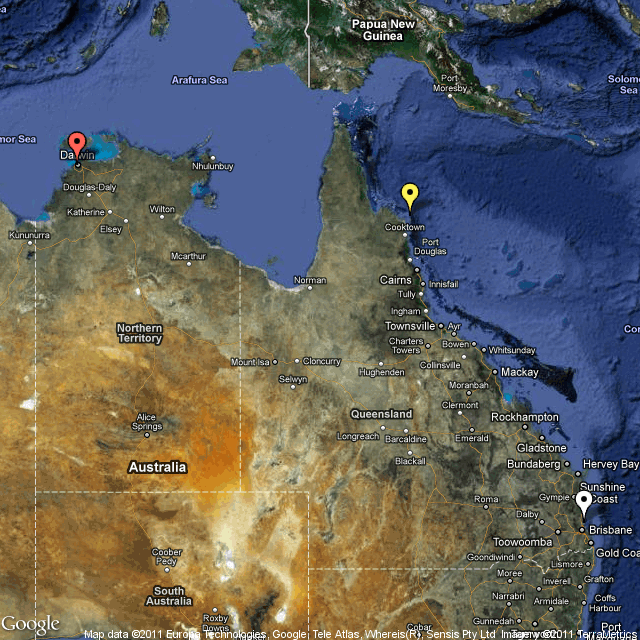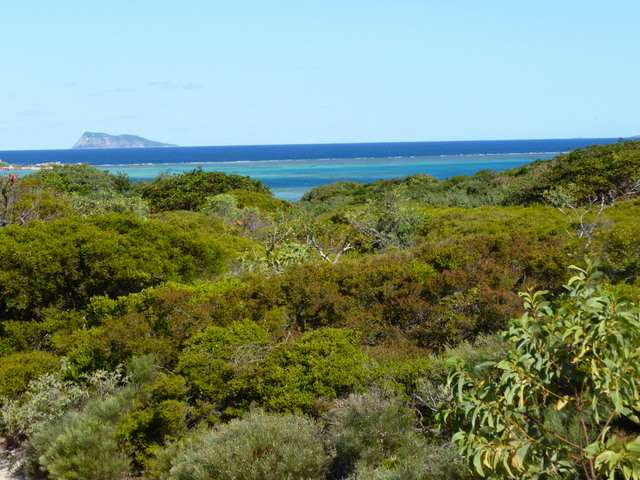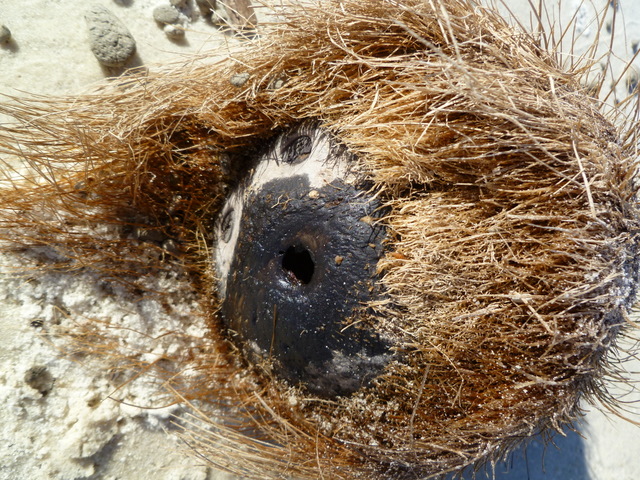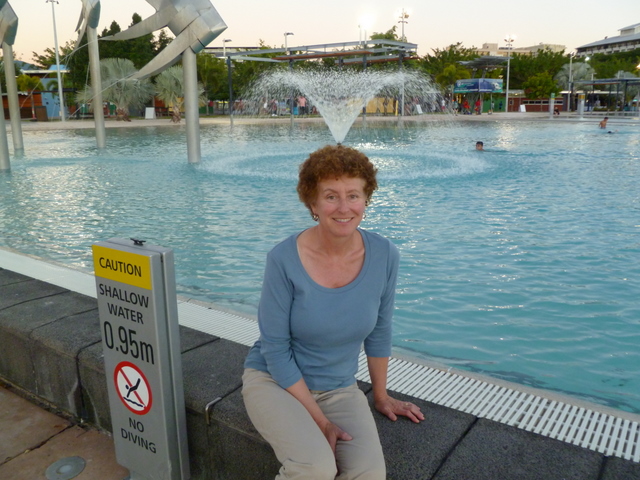M.
Oxley Island
One step closer to Darwin
The very cool part about the trip was the first 6 hours when we left Mt. Adolphus and had to pass by several small islands (including a Tuesday, Wednesday, Thursday and Friday Island) and a number of reefs before entering into the open and unobstructed waters of the GOC. The area is called the Torres Straits and it is a band of water that flows south of Papua New Guinea and just over the northern coast of Australia, connecting the Pacific and the Indian Oceans. It is famous for its boat traffic and its strong currents. If you time the currents right (which we did) you can pick up an additional 5 knots of boat speed. That means that if you are sailing along at 6 or 7 knots (a typical speed for us), you can suddenly be going 11 or 12 knots. We had a crystal clear day and the seas in the Torres Straight were flat and aquamarine blue and we absolutely flew along for the first few hours at speeds of up to 12 knots. It was really amazing. We were sailing with a new friend of ours, Northern Winds, who has a magnificent boat and they were blazing along at up to 14 knots.
After that we were in the aquamarine Sea of Arafura (Ever hear of it before? I had not. It opens to the Indian Ocean.) and crossed the Gulf of Carpentaria (see our last blog for a map). We went with a good wind forecast and a relatively light sea swell forecast (
We had another surprise at the end of the trip when we rounded the northern most tip of the Wessel Islands – a long, thin strip of islands that mark the western border of the Gulf of Carpentaria. As we approached the tip we noticed that the water ahead of us was a totally different color and swirling and filled with white-caps. Suddenly we were in the most beautiful, strange, and furious looking water that we have seen for some time. We had arrived at the tip of the island (where currents and wind can be strongest) at a time of day when the current was moving towards us while the wind and waves were coming up behind, making a confused and swirling sea state. The water was 50 meters deep, and obviously soft white sand on the bottom and the whirling water was creating patterns of various shades of blue, depending on how much sand was swirling up. The swells were large and it was difficult to go faster than 2.5 knots (rather than the 8 knots we were doing just before that) because the current was pushing us one direction while the wind was pushing us another. The water was such a beautiful color – which I have tried to capture in pictures and video. We were glad to have reached that point while it was still daylight and while the winds were relatively light. I would imagine it would be unnavigable during certain conditions.
Once we turned the corner at the tip of the Wessel Islands we were out of the churn and the tumult and we proceeded another few miles down the coast to a beautiful protected anchorage where there are 6 or 7 other boats – all heading to Darwin. Slept about 12 hours last night and feeling fine…..
L.
Safe arrival at Marchinbar Island
M.
At the top of Australia
We are now past the top of the continent of Australia. Yesterday afternoon we arrived at Blackwood Bay on the west side of Mount Adolphus Island after a very fast sail from Margaret Bay. Our coordinates are:
S 10 degrees 38.63 minutes
E 142 degrees 38.62 minutes
The last time we anchored this far north was the Galapagos Islands. This is, of course, the farthest west Sabbatical III has ever been.
Yesterday we sailed in 20-25 knots winds that pushed the boat along at 8 to 8.5 knots. Three freighters passed us in the channel during the sail in what seemed to be slow motion. There seems to be a 14 knot speed limit in the channel along the Great Barrier Reef, so a freighter going north (which is all we saw) only closes on us at 6 knots or less. Our AIS makes us aware of then more than 20 miles away, and tells us that they will approach us in 3 hours. In three hours we can have lunch, take a nap, and then deal with freighter traffic. If only it was this way all the time with freighters.
The wind, seas, and currents are all perfect for our departure across the Gulf of Carpenteria starting tomorrow morning (June 19). We will leave here (Mt. Adolphus) at about 0930 local time and catch the strong tidal steam as it turns to the west along our various legs through the Torres Strait, following the Prince of Wales Channel. It is 361 nautical miles to Two Island Bay in Marchinbar Island. The course is about 265 degrees magnetic once we clear the Straits. The forecast is for winds of 15-20 knots from the southeast andd seas less than 2 meters for the whole trip to Marchinbar.
The attached map shows where we have been where we are, and where we are going. The yellow icon is Scarborough (Redcliffe), our starting point this year, the green icon is Mount Adolphus Island, our current position, the white icon is Marchinbar Island in the Wessel Islands, our next stop, and the red icon is Darwin, our last stop in Australia.
M.
Margaret Bay and beyond
We sailed to Margaret Bay (behind Cape Grenville) yesterday (Wednesday) in brisk winds and somewhat confused seas. It was a fast sail. We decided to spend the day here today and rest and plan our next passages. Some other Rally boats came in today and Laura joined them for a walk ashore while I worked on issues of tides, currents, and winds. There was a small (8 foot) crocodile on the far end of the beach, so Laura and her companions walked the other way.
The usual course from here is to sail to Escape River (80 miles north) and anchor, and then proceed around the tip of Cape York the next day via the Albany Channel, ending up at Seisa. However, it would be dead low tide when we arrived at Escape River, made very low by the full moon, and we have had a friend who recently went aground there. I do not want to enter the river at anything less than half tide. Moreover, the next day it would be difficult to avoid an adverse current in the Albany Channel. So we now have a different plan. We will leave here at 3:30 am and head for Mount Adolphus Island going outside of Albany and north of Cape York. That is a passage of 90 miles. The bay on the west side of Mount Adolphus looks like it would be secure. Cape York is the northern most point of continental Australia.
After a day of rest, we plan to sail well north of Cape York and take the Prince of Wales Channel through the Torres Strait and on to Marchinbar Island at the north end of the Wessel Islands. This latter passage is about 360 miles and will take 48-56 hours depending on conditions. Our friends on “Wombat of Sydney” anchored at Two Island Bay at Marchinbar Island last night and said it was very secure and provided me with lat-long and entry info. From the Wessel Islands we will plan the rest of our journey to Darwin, which will then be just a few days more away.
In going from Mount Adolphus to the Wessel Islands we are crossing the Gulf of Carpenteria, or as some sailors call it, the Gulf of Crap-iteria because of the uncomfortable sea conditions that are common. Looking ahead, we see a weather window of somewhat better seas starting on Sunday so we hope to cross the Gulf on Sunday and Monday and arrive at the Wessels on Tuesday morning. We will try to post an update from (uninhabited) Mount Adolphus Island.
M.
From Flinders Island to Morris Island
The wind came up at 1 am this morning. We know since it generated a steep chop in the anchorage that hit the boat at the stern (wind and current were not from the same direction). Nothing to be done but try to sleep as well as we could as the boat pitched around. We left at 7 am for Morris Island, about 60 miles away. We were able to sail for the first 6 hours but then the wind died again and we had to motor for 3 hours before we got a little breeze again. On the bright side, the seas were quite flat except for those hours at anchor. There are five other Sail Indonesia Rally boats here (one US, one Canada, one Brazil, one France, and one Australia) and I expect all will head for the same place we will head tomorrow — Portland Roads. But if the wind is too light, I think we may just wait another day at anchor.
M.
Eagle Island

We are still at Eagle Island. Yesterday the smoke from the fires on Lizard Island diminished and the boats that were with us either returned to Lizard Island, or continued north. We were going to continue north today as well. But I got on a Skype session with a professional colleague (we still have access to 3G from Lizard) about our research collaboration, and the day went by without us getting prepared. So we decided to stay here another day.
We were able to snorkel in three different places on the reef around Eagle Island and it was quite nice, although a bit on the cool side. The highlight is the giant clams. The biggest are 3 feet (1 meters) across and about 2 feet (0.6 meter) tall, and must weigh a couple of hundred pounds. That is a lot of clam. They are the largest bivalve mollusks in the world. The color of their lips vary from clam to clam. Below is a photo we took of a smallish one that was just below were we anchored the dinghy.

We are planning to leave for the Flinders Islands tomorrow (Saturday) morning at 0400. It is about an 80 nautical mile sail. There is no shortage of wind this week. It is unlikely that we will have internet access for the next week, but we cannot know until we get there. We will continue to day sail up the coast until we round Cape York and move away from the Great Barrier Reef.
M.


Fire
We were expecting to spend a few more days in Lizard Island, as were almost a dozen boats at anchor there, until two National Park Rangers came by the day before yesterday to tell us that they were going to start a controlled burn of brush and grass the next day and that we should strongly consider leaving. That was a bolt out of the blue. Yesterday morning early, quite a few boats left for the longish passage to the next secure anchorage, Flinders Island, about 75 miles away. About 6 boats decided to stay and see how much smoke and ash there would be.
Sabbatical III left to try anchoring behind tiny Eagle Islet about 5 miles away. We were prepared to sail on if we could not find secure anchorage there. With Laura up in the mast to look for coral and rocks, we anchored fairly comfortably in uncharted waters. This morning, the second days of fires at Lizard, five other boats came over to join us after we told them that Eagle Islet was a decent anchorage and the smoke and ash at Lizard became worse. At least we had the opportunity to hike the two best trails at Lizard. The newly arrived boats did not hike at all and the trails are closed for 4 more days.

White is Scarborough, Yellow is Lizard Island, Red is Darwin
M.
Lizard Island

We arrived at Lizard Island yesterday (Saturday) morning after a great 23 hour sail from Cairns. The wind was very light for the first hours but then came up and stayed 12-15 knots throughout the night. The Great Barrier Reef, which is really a set of discrete coral reefs, is quite close to the mainland this far north in Australia. As a consequence, the seas are quite calm inside the reef. So calm, that Laura slept in the forward berth while off watch during the night — the first time we had done that since we left the US. The forward berth is the most bouncy and loud place on the boat while underway. The drawback to the proximity of the Great Barrier Reef to the mainland is that we have to sail a zigzag course avoiding numerous reefs. As a matter of safety, we had never sailed among reefs at night, until for the trip to Lizard Island. The Australian nautical charts are spot-on and as long as we kept aware of our position, we knew we would be OK. We sailed right by Endeavor Reef where Captain Cook and his vessel “Endeavor” was almost lost in 1770 soon after he “discovered” Australia for England. It was only by heroic effort that “Endeavor” was freed from the reef and repaired to continue it’s voyage home. If it had not, Australia would likely have become French.
After repairing his vessel at Cape Tribulation, Captain Cook looked for a way out of the Great Barrier Reef and so he sailed to Lizard Island where he could see a high hill/mountain in the distance. By climbing this hill, which provides a sweeping view up and down the reef, Cook found a way out to the open ocean. So today, accompanied by Mike and Lynn of “Wombat of Sydney” we climbed to Cook’s Lookout. It was an arduous 90 minutes climb to the top but the views were spectacular.

Lizard Island is mostly a national park but there is a very expensive (AUD$1100 per night) resort on the island, and a marine research station. It is the most secure anchorage around and is (almost always) crocodile free, so it is a must stop for sail boats heading to Darwin. There are seven boats in the anchorage at Watson’s Bay on the west side of the island. One advantage of having a resort on the island is that there is 3G cellular service. That allows us to connect to the internet using our USB dongle modem. Once we leave Lizard Island there will be no internet access until we arrive at Darwin around July 1.
The trip here from Cairns was easy enough that we still had the energy to set up the dinghy and go to shore and have a hike to the “Blue Lagoon” right after we arrived yesterday. The Blue Lagoon is a reef coral atoll abutting the southwest corner of the island. Not a good place to anchor in most weather, but worth a hike across the island to see.
The resort opens their beach bar to yachties on Friday and Sunday night, so almost everyone at anchor came ashore this evening for drinks and fish and chips at reasonable prices. Tomorrow we will snorkel the nearby reef which contains many giant clams that are each a few feet across and very colorful. We plan to spend a few days more here before moving on. We have about 1200 nautical miles left to sail until we reach Darwin, so we cannot linger for too long.
M.






Leaving for Lizard Island
We will leave Cairns late in the morning (Friday) heading for Lizard Island, about 140 nautical miles to the northwest. It is supposed to be a beautiful place where one can actually swim without worrying too much about crocodiles. We have not been in the water yet this year. First, it has been surprisingly cold for the season — down into the high 50’s at night. Second, the floods of the first months of the year led to large quantities of silt washing into the sea, reducing visibility. Third, Cyclone Yasi, which hit northern Queensland a few months ago, also stirred up the water and killed large areas of coral on the Great Barrier Reef. Friends who are currently at Lizard Island have communicated to us that the water is clear and the coral healthy there.
Today we went to the botanical gardens and strolled the boardwalk at sunset to watch the lorikeets congregate. The photo below is of the public pool where Laura has gone to swim at 7 am in the morning when it is still (relatively) frigid. At that time she can do laps. The second photo tells you why everyone swims in the large public pool, and not in the ocean.
M.



